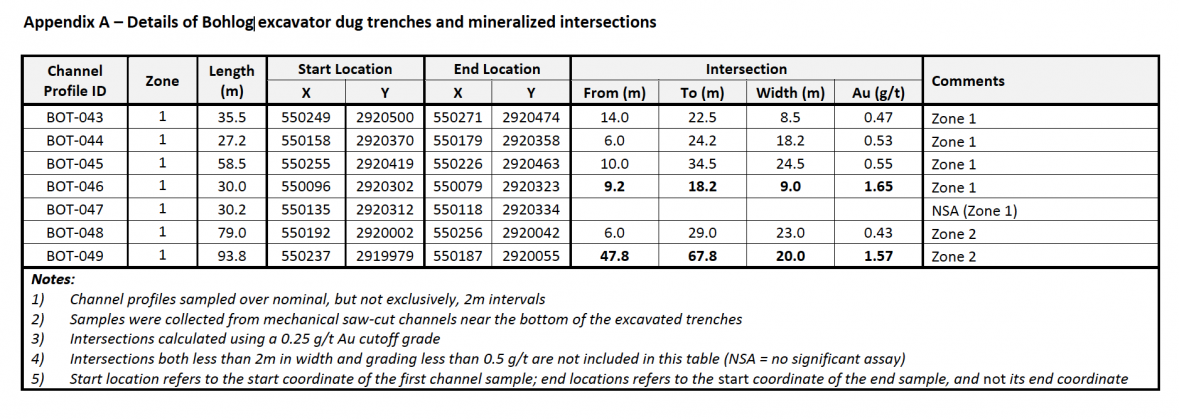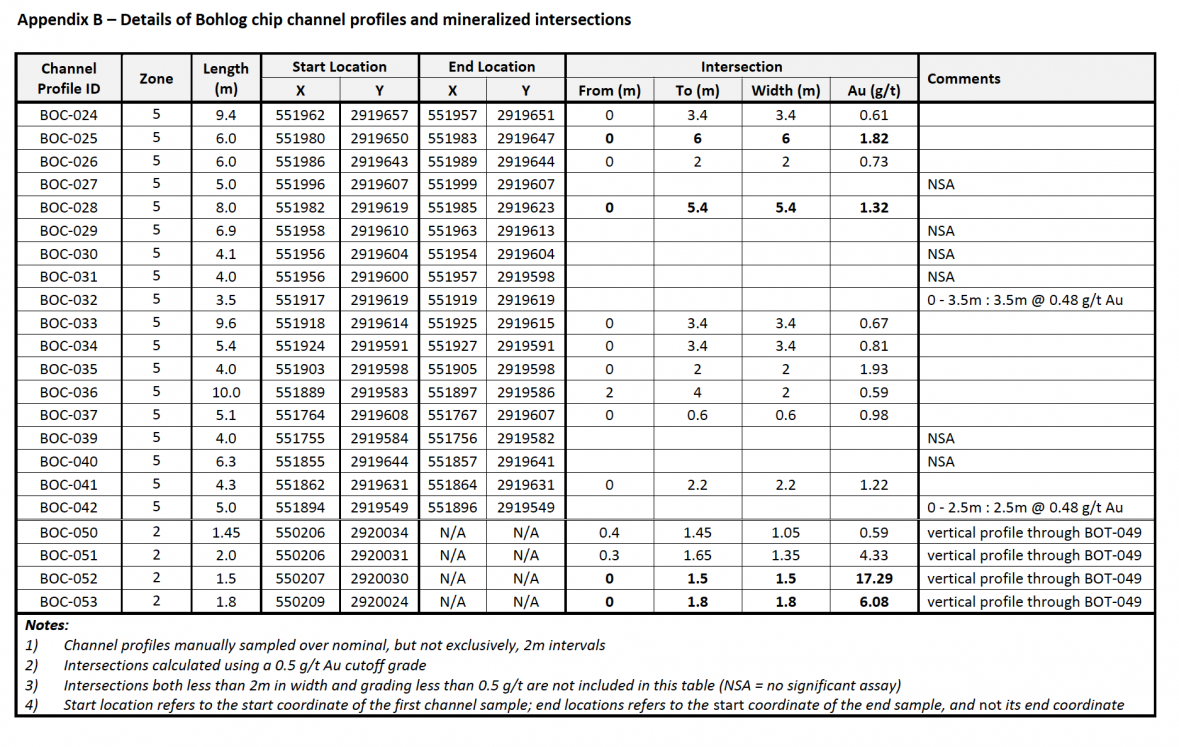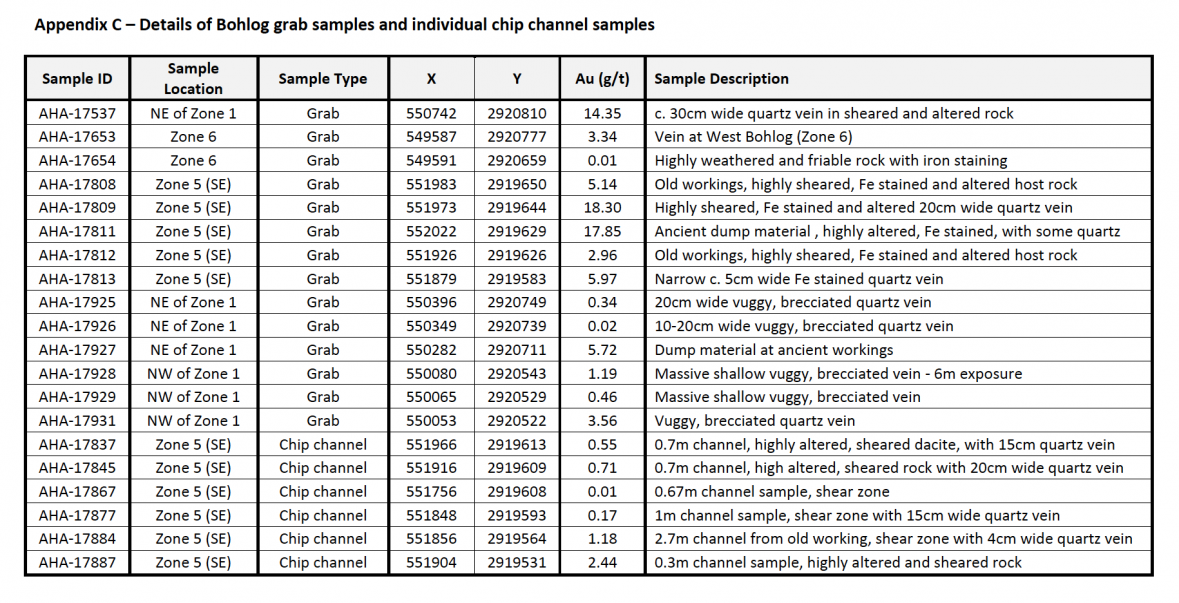Aton Announces The Results Of Excavator Trenching At The Bohlog Prospect, Including Mechanical Saw-cut Channel Sample Intersections Of 20 Metres At 1.57 G/t Gold
Vancouver, February 28, 2018: Aton Resources Inc. (AAN: TSX-V) (“Aton” or the “Company”) is pleased to provide investors with an update on recent excavator trenching, and surface channel and grab sampling at the Bohlog prospect, at the Company’s 100% owned Abu Marawat Concession (“Abu Marawat” or the “Concession”), located in the Eastern Desert of Egypt.
Highlights:
- Mechanical saw-cut channel sampling of excavator dug trenches at Zones 1 and 2 of the Bohlog prospect has returned mineralized intersections from surface including 20m @ 1.57 g/t Au (trench BOT-049, Zone 2), and 9m @ 1.65 g/t Au (trench BOT-046, Zone 1);
- Follow-up surface chip channel profile sampling of the recently discovered Zone 5 at Bohlog SE has returned assays of 6m @ 1.82 g/t Au (profile BOC-025), and selective surface grab sampling has returned assays of up to 18.3 g/t Au from sheared quartz veins;
- Additional mineralized quartz veins have been identified in the immediate Bohlog area, and selective grab sampling of these veins has returned assays including 14.35 g/t Au (NE of Zone 1), 3.56 g/t Au (NW of Zone 1) and 3.34 g/t Au (Zone 6).
“We are very pleased with these latest trench and sampling results from Bohlog,” says Mark Campbell, President and CEO. “Along with our recent major discovery at Rodruin, these results continue to re-emphasize the overall prospectivity of our license area. We are looking forward to receiving and reporting further assay results from Rodruin in the very near future, and we are just starting construction of the access road in to Rodruin, in advance of the planned drilling program. And our work continues apace with the proposed development of a heap leach open pit mine at Hamama West. Recent bulk metallurgical testing has come back with good results, with above average gold recoveries and fast leach kinetics from the column leach tests, and we have started geotechnical work at potential heap leach pad locations.”
Bohlog Prospect
Bohlog is located approximately 17km ENE of Hamama (see Figure 1), and approximately 8km N of the Rodruin prospect, which has become the Company’s primary exploration focus. Bohlog is centred in an area of ancient workings near the ruins of a large settlement, suggesting that it was historically a significant mining area in ancient times. In 2012 the Company carried out limited sampling in the Bohlog area (see news release dated August 15, 2012), returning gold grades of up to 18.65g/t Au from channel samples of mineralized quartz veins. In early 2017 the Company’s field crews followed up on this initial work, carrying out a program of grab and channel sampling which returned assays of up to 21.1 g/t Au, and identified 4 separate mineralized zones, and visible gold in several samples (see news release dated June 7, 2017). Later on in 2017 further mapping and surface channel profile and grab sampling was undertaken, leading to the discovery of Zone 5 approximately 2km SE of the main Village Zone (Zone 1) at Bohlog (see news release dated December 4, 2017).
Mineralization at Bohlog is spatially related to the late Bohlog granite (see Figure 2), which is intruded into early orogenic ‘grey granites’, comprising primarily granodioritic rocks in the immediate Bohlog area. The Bohlog granite has superficial spectral similarities to the Gaharish granite, which hosts the mineralization at
Abu Gaharish (see Figure 1), and these 2 granites may be genetically related. The quartz vein mineralization at Bohlog occurs both within the Bohlog granite, and also within the surrounding ‘grey granites’, and is associated with structurally controlled zones of stringer and stockwork style mineralization displaying intense phyllic alteration. The geological setting, with mineralization close to the margin of a late granite, a distinctive Au-W-Pb-Cu geochemical signature, and the strong structural controls all indicate a similarity to the mineralization at Abu Gaharish (see news release dated December 19, 2017). The geological setting of the mineralization, the nature and composition of the alteration, and the metallogenic signature all continue to suggest a possible reduced intrusion related (RIRG) affinity to the Bohlog mineralization.

Figure 1: Abu Marawat regional geology, showing the location of the Bohlog prospect
Late 2017 Bohlog trenching and sampling program
The Company has undertaken a program of trenching at Bohlog, using our onsite Caterpillar 225 excavator to dig the trenches, which were completed to a nominal depth of c. 1m, cleaned, photographed and logged prior to sampling. In total 7 trenches were excavated (BOT-043 to BOT-049), for a total length of 354.2m (see Figures 3 and 4). Mechanical saw-cut channels were cut near the bottom of the trenches, and were sampled over nominal 2m intervals. All samples were crushed at the Company’s onsite preparation facility to an approximate -4mm fraction, and c. 500g splits were shipped to ALS Minerals at Rosia Montana, Romania for analysis. Samples were analyzed for gold by fire assay using analytical code AA-Au23 (repeated by AA-Au25 for samples which returned gold grades greater than 10 g/t).
A comprehensive summary of all the mineralized intersections from the excavator dug trenches is provided in Appendix A, which included intersections of 20.0m @ 1.57 g/t Au (BOT-049 in Zone 2, Figure 4), and 9.0m @ 1.65 g/t Au (BOT-046 in Zone 1, Figure 3). All the trenches intersected significant zones of mineralization at surface, up to 24.5m in width, except trench BOT-047 (see Figure 3). It is also noted that the sampled widths almost certainly underestimate the true grade of the mineralized zones as narrow high grade quartz veins had been removed from the trench profiles in shallow surface workings by the ancient miners.
Additionally 4 short vertical channel profiles (profiles BOC-050 to BOC-053) were sampled in trench BOT-049 (Zone 2, Figure 4) across a series of discrete flat-lying quartz veins, within the main stockwork mineralized zone. These recorded true width intersections across these veins including 1.5m @ 17.3 g/t Au (profile BOC-052) and 1.80m @ 6.08 g/t Au (profile BOC-053). A number of sections in both trenches BOT-048 and BOT-049 could not be sampled close to where the 2 trenches crossed each other due to the presence of infilled workings intersected in the trenches.
The strong phyllic alteration logged in the trenches, the presence of a system of narrow Au-bearing stockwork veins, and the broader widths of a lower grade mineralization envelope around the quartz veins intersected in the trenches, all continue to support the potential development of reduced intrusion related mineralization at Bohlog.
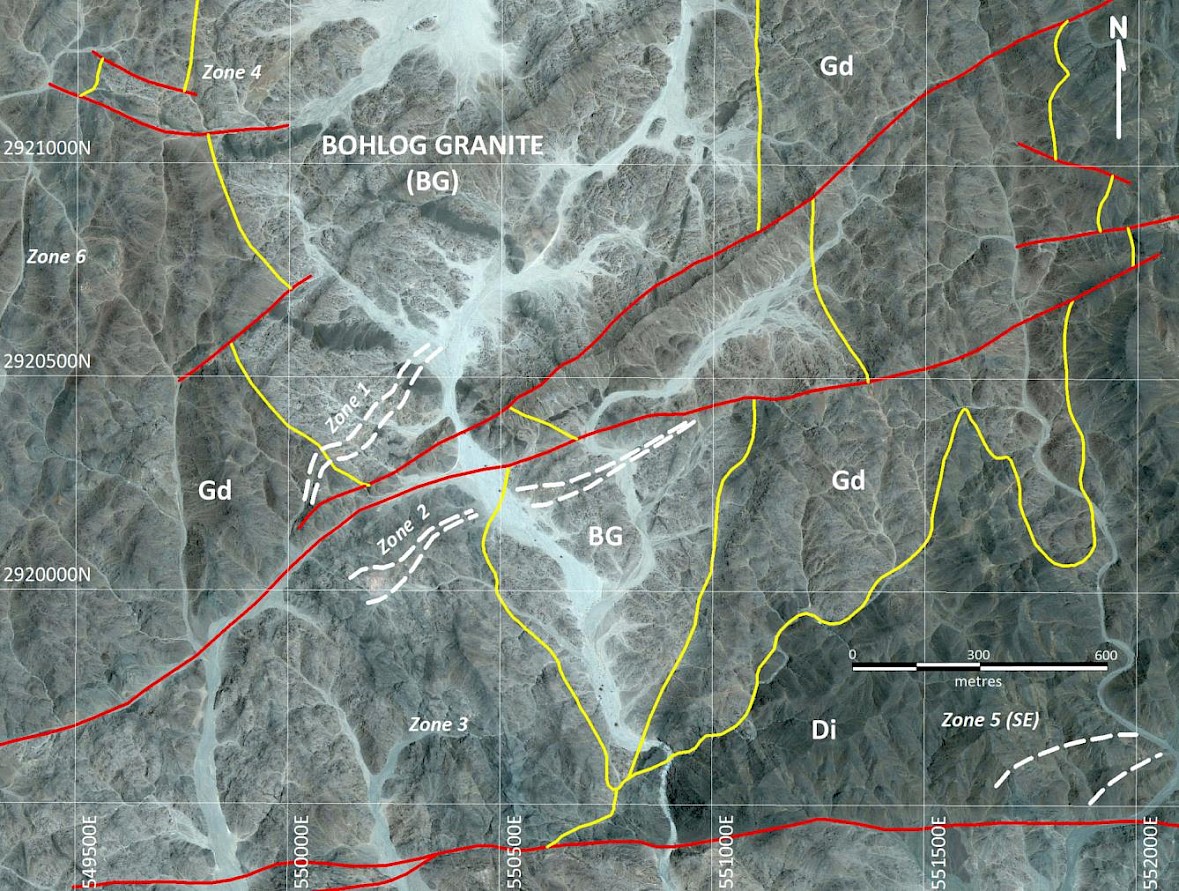
Figure 2: Interpreted geology of the Bohlog project, with locations of different zones (legend: BG - Bohlog granite; Gd – granodiorite; Di – diorite; red – interpreted and mapped faults, yellow – interpreted geological contacts)
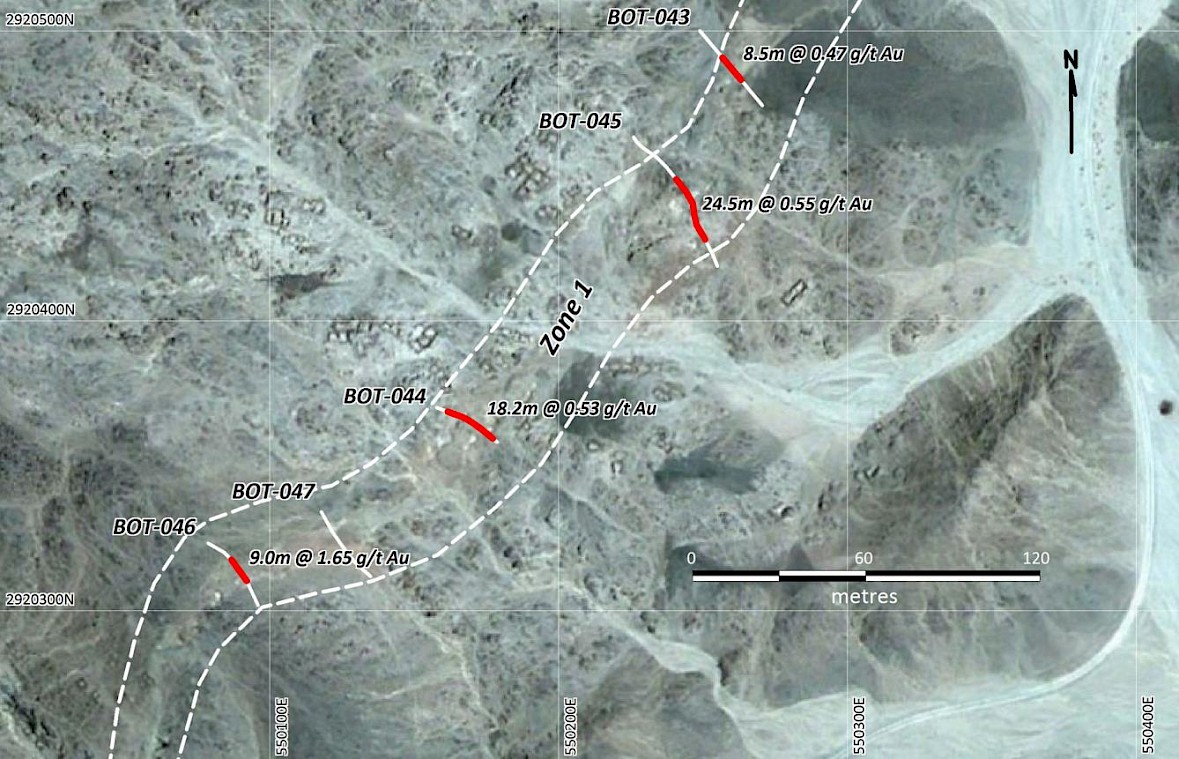
Figure 3: Location plan showing trenches and surface mineralized intersections - Zone 1 (trenches BOT-043 to BOT-047), mineralized intersections shown in red
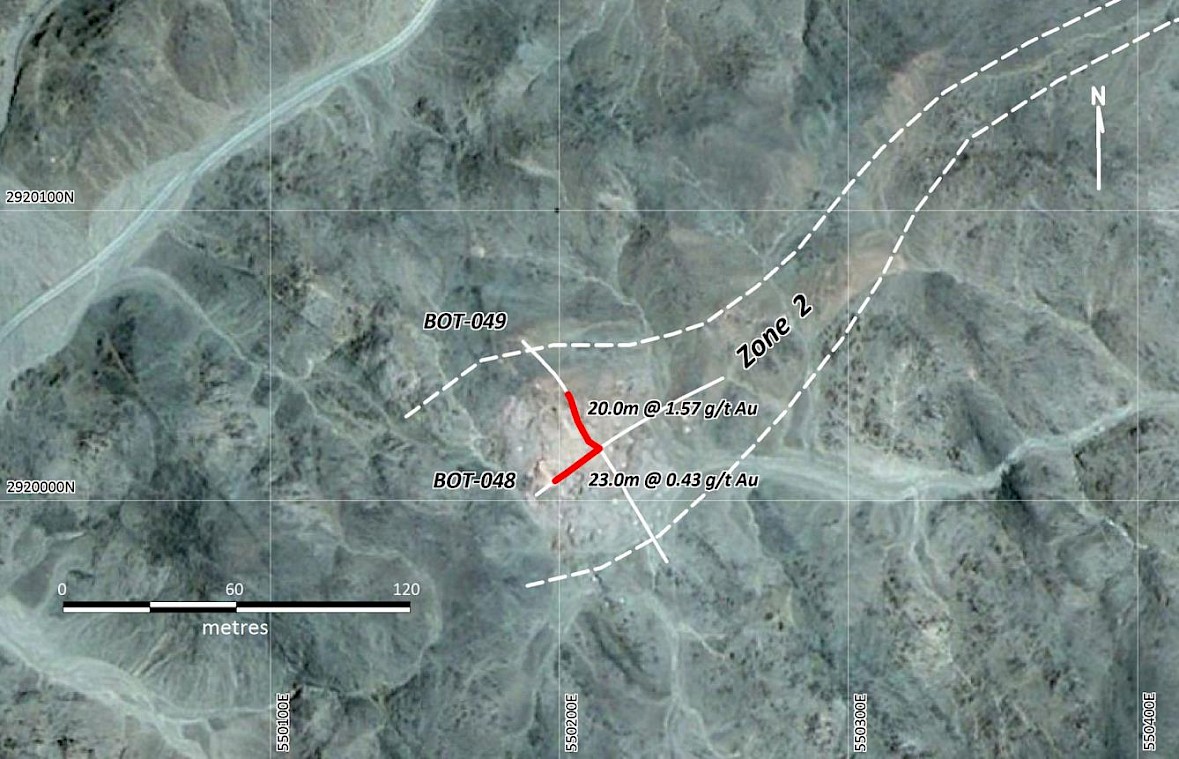
Figure 4: Location plan showing trenches and surface mineralized intersections - Zone 2 (trenches BOT-048 and BOT-049), mineralized intersections shown in red (note: not true widths of the mineralized zone, due to the presence of unsampled intervals within the trenches)
At the Zone 5 area a total of 19 short surface chip channel profiles were manually sampled in late 2017 (see Figure 5). 61 samples were collected over nominal 2m intervals from the channel profiles for a total sampled length of 118.5m. A further 5 grab samples and 6 short individual channel samples were also collected from the Zone 5 area. Most of the surface channel profiles intersected mineralization with intersections including 6.0m @ 1.82 g/t Au (profile BOC-025) and 5.4m @ 1.32 g/t Au (profile BOC-028). Selective surface grab samples returned grades of up to 18.30 g/t Au and 17.85 g/t Au from sheared quartz veins and ancient dumps, and individual channel samples returned assays of up to 2.44 g/t Au. Mineralization was intersected over an area covering at least 275m x 125m. Full details of the channel profiles, and all individual channel and grab samples are provided in Appendix B.
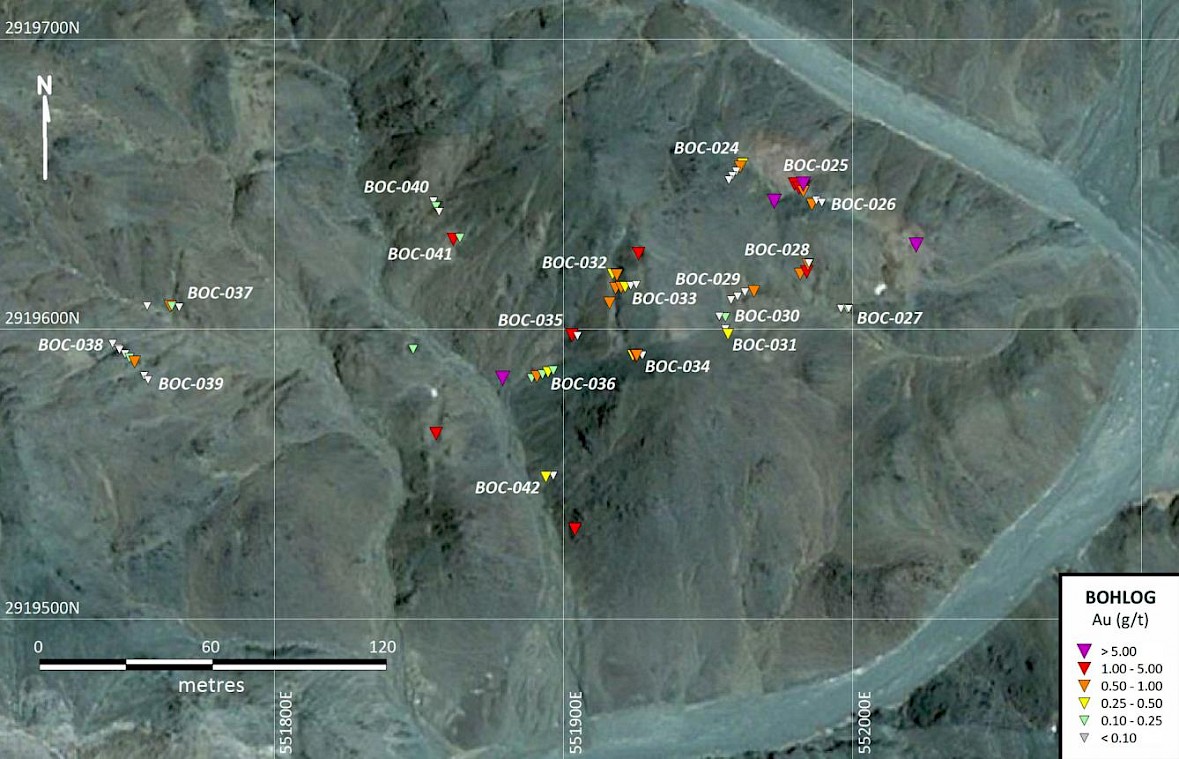
Figure 5: Location plan showing chip channel profiles, and individual channel and grab samples - Zone 5
A further total of 9 selective grab samples were collected to the north of Zone 1, including 2 from some small ancient workings to the NW, which have been designated as Zone 6 (see Figure 6). A single grab sample from a quartz vein along strike to the NE of Zone 1 returned an assay of 14.35 g/t Au, while grab samples from further mineralized quartz veins at Zone 6 and an area to the NW of Zone 1 returned assays of 3.34 g/t Au and 3.56 g/t Au, respectively. Of the 9 samples, 5 returned assays greater than 1 g/t Au.
The Company continues to be very encouraged by the ongoing identification of mineralized quartz veins over a wide area at the Bohlog prospect, and the positive results from the trenches, indicating zones of potential RIRG style mineralization outcropping at surface at Zones 1 and 2. A short drilling program is now being planned at Bohlog to follow up on the positive exploration results returned to date.
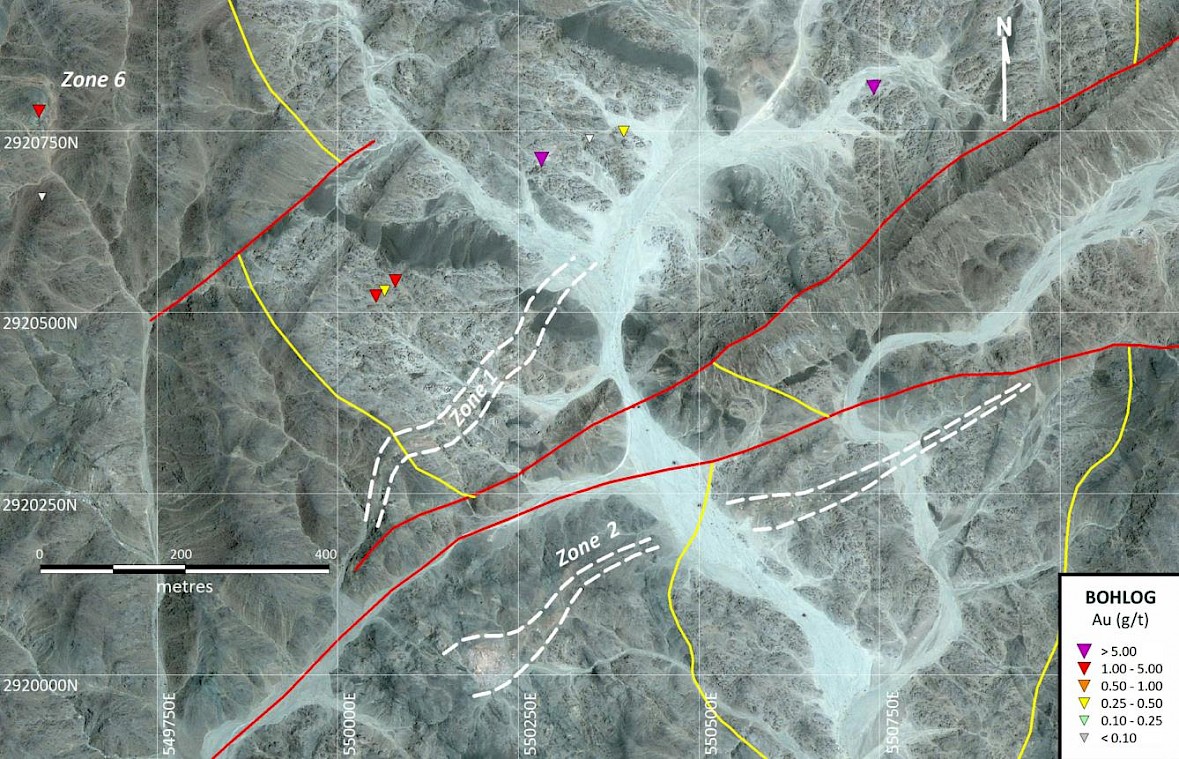
Figure 6: Location plan showing grab samples - Zone 6 workings, and areas to the north of Zone 1
Activity update
- Column cyanide leach testing of the four 120kg bulk composite samples of oxide and transitional mineralized material from the Hamama West deposit has been completed and the final report has been received from Wardell Armstrong International. Au recoveries average 75.6% and 72.7% from the oxide and transitional zones samples, and are considered to be above the average of those of comparable heap leach gold projects. The column tests also indicated very fast leach kinetics for all oxide and transitional samples;
- Geotechnical trial pitting at 2 potential locations for the Hamama West heap leach facility has commenced, and is currently in progress;
- A final review of the deep ground penetrating radar geophysical survey undertaken over the Waayrah, Miranda VMS, Abu Gaharish, Sir Bakis, Semna, Bohlog and East Eradiya prospects is being completed. Following the completion of this review it is anticipated that the final report on this program will be completed by the contractor Terravision Exploration within the next 2-3 weeks.
- Additional surface sampling has been completed at the recently discovered Rodruin prospect to follow up the highly encouraging initial surface sampling results (see news release dated February 6, 2018). Samples have been dispatched to ALS Romania for analysis, and further updates will be provided shortly.
About Aton Resources Inc.
Aton Resources Inc. (AAN: TSX-V) is focused on its 100% owned Abu Marawat Concession (“Abu Marawat”), located in Egypt’s Arabian-Nubian Shield, approximately 200 km north of Centamin’s Sukari gold mine. Aton has identified a 40 km long gold mineralized trend at Abu Marawat, anchored by the Hamama deposit in the west and the Abu Marawat deposit in the east, containing numerous gold exploration targets, including three historic British mines. Aton has identified several distinct geological trends within Abu Marawat, which display potential for the development of RIRG and orogenic gold mineralization, VMS precious and base metal mineralization, and epithermal-IOCG precious and base metal mineralization. Abu Marawat is over 738km2 in size and is located in an area of excellent infrastructure, a four-lane highway, a 220kV power line, and a water pipeline are in close proximity.
Qualified Person
The technical information contained in this News Release was prepared by Roderick Cavaney BSc, MSc (hons), MSc (Mining & Exploration Geology), FAusIMM, GSA, SME, Vice President, Exploration, of Aton Resources Inc. Mr. Cavaney is a qualified person (QP) under National Instrument 43-101 Standards of Disclosure for Mineral Projects.
For further information regarding Aton Resources Inc., please visit us at https://www.atonresources.com/ or contact:
Mark Campbell
President and Chief Executive Officer
Tel: +1-936-689-2589
Email: mcampbell@atonresources.com
Note Regarding Forward-Looking Statements
Some of the statements contained in this release are forward-looking statements. Since forward-looking statements address future events and conditions; by their very nature they involve inherent risks and uncertainties. Actual results in each case could differ materially from those currently anticipated in such statements.
Neither TSX Venture Exchange nor its Regulation Services Provider (as that term is defined in policies of the TSX Venture Exchange) accepts responsibility for the adequacy or accuracy of this release.
